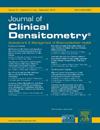轴位和矢状位CT测量对骨质疏松症的诊断准确性:多椎体评估
IF 1.6
4区 医学
Q4 ENDOCRINOLOGY & METABOLISM
引用次数: 0
摘要
背景:本研究旨在评估轴向和矢状位ct衍生的Hounsfield Unit (HU)值在识别骨质减少和骨质疏松症中的诊断准确性。此外,它还研究了与单水平评估相比,多个椎体水平的组合是否能提高预测性能。方法:这项回顾性研究包括346名患者,他们在6个月内接受了双能x线吸收仪(DXA)和胸部非对比计算机断层扫描(CT)扫描。轴向和矢状面HU测量来自关键椎体水平,包括T4、T7、T10、T12和L1。采用Logistic回归和受试者工作特征(ROC)分析来评估单个和联合椎体模型的诊断性能。排除有椎体转移、血管瘤、压缩性骨折或严重畸形的患者。结果:矢状面T4椎体测量个体AUC最高(0.810),具有较强的诊断潜力。结合T4和L1测量使AUC提高到0.828,而六椎体模型的AUC略高,为0.844。尽管有这种微小的改进,但更简单的双椎体模型在临床环境中具有实际优势。使用约登指数确定最佳临界值,T4S为164 HU, L1S为133 HU,均具有高特异性,但敏感性中等。结论:轴位和矢状位CT测量,特别是T4和L1水平,显示出诊断骨质减少和骨质疏松症的强大潜力。虽然简单的模型仍然有效,但结合多个椎体水平可以提高预测准确性。机会性CT筛查,利用其他临床目的的扫描,为DXA提供了实用和经济的替代方案,实现了早期干预和全面的骨质疏松症管理。本文章由计算机程序翻译,如有差异,请以英文原文为准。
Diagnostic accuracy of axial and sagittal CT measurements for osteoporosis: A multi-vertebra evaluation
Background: This study aims to assess the diagnostic accuracy of axial and sagittal CT-derived Hounsfield Unit (HU) values in identifying osteopenia and osteoporosis. Additionally, it investigates whether the combination of multiple vertebral levels enhances predictive performance compared to single-level assessments.
Methodology: This retrospective study included 346 patients from who underwent both dual-energy X-ray absorptiometry (DXA) and non-contrast thoracic computed tomography (CT) scans within a 6-month interval. Axial and sagittal HU measurements were obtained from key vertebral levels, including T4, T7, T10, T12, and L1. Logistic regression and receiver operating characteristic (ROC) analyses were performed to evaluate the diagnostic performance of individual and combined vertebral models. Patients with vertebral metastases, hemangiomas, compression fractures, or severe deformities were excluded.
Results: The sagittal T4 vertebra measurement achieved the highest individual AUC (0.810), indicating strong diagnostic potential. Combining T4 and L1 measurements improved the AUC to 0.828, while a six-vertebra model yielded a slightly higher AUC of 0.844. Despite this marginal improvement, simpler two-vertebra models offer practical advantages in clinical settings. Optimal cut-off values were determined using Youden’s Index, with T4S at 164 HU and L1S at 133 HU, both showing high specificity but moderate sensitivity.
Conclusions: Axial and sagittal CT measurements, particularly at T4 and L1 levels, demonstrate strong potential for diagnosing osteopenia and osteoporosis. Combining multiple vertebral levels offers improved predictive accuracy, although simpler models remain effective. Opportunistic CT screening, utilizing scans performed for other clinical purposes, provides a practical and cost-effective alternative to DXA, enabling early intervention and comprehensive osteoporosis management.
求助全文
通过发布文献求助,成功后即可免费获取论文全文。
去求助
来源期刊

Journal of Clinical Densitometry
医学-内分泌学与代谢
CiteScore
4.90
自引率
8.00%
发文量
92
审稿时长
90 days
期刊介绍:
The Journal is committed to serving ISCD''s mission - the education of heterogenous physician specialties and technologists who are involved in the clinical assessment of skeletal health. The focus of JCD is bone mass measurement, including epidemiology of bone mass, how drugs and diseases alter bone mass, new techniques and quality assurance in bone mass imaging technologies, and bone mass health/economics.
Combining high quality research and review articles with sound, practice-oriented advice, JCD meets the diverse diagnostic and management needs of radiologists, endocrinologists, nephrologists, rheumatologists, gynecologists, family physicians, internists, and technologists whose patients require diagnostic clinical densitometry for therapeutic management.
 求助内容:
求助内容: 应助结果提醒方式:
应助结果提醒方式:


